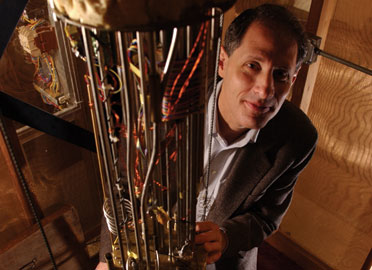Home > Press > Physicists harness effects of disorder in magnetic sensors
 |
| University of Chicago physicist Thomas Rosenbaum, with the helium dilution refrigerator in his laboratory, where he observes the quantum behavior of materials chilled to temperatures approaching absolute zero. (Photo: Dan Dry) |
Abstract:
University of Chicago scientists have discovered how to make magnetic sensors capable of operating at the high temperatures that ceramic engines in cars and aircraft of the future will require for higher operating efficiency than today's internal combustion technology.
The key to fabricating the sensors involves slightly diluting samples of a well-known semiconductor material, called indium antimonide, which is valued for its purity. Chicago's Thomas Rosenbaum and associate Jingshi Hu, now of the Massachusetts Institute of Technology, have published their formula in the September issue of the journal Nature Materials.
Physicists harness effects of disorder in magnetic sensors
Chicago, IL | Posted on September 9th, 2008Most magnetic sensors operate by detecting how a magnetic field alters the path of an electron. Conventional sensors lose this capability when subjected to temperatures reaching hundreds of degrees. Not so in the indium antimonide magnetosensors that Rosenbaum and Hu developed with support from the U.S. Department of Energy.
"This sensor would be able to function in those sorts of temperatures without any degradation," said Rosenbaum, the John T. Wilson Distinguished Service Professor in Physics.
Rosenbaum's research typically focuses on the properties of materials observed at the atomic level when subjected to temperatures near absolute zero (minus-460 degrees Fahrenheit). More than a decade ago, he led a team of scientists in experiments involving silver selenide and silver telluride, two materials that exhibited no magnetic response at low temperatures. But when the team introduced a tiny amount of silver (one part in 10,000) to the materials, their magnetic response skyrocketed.
In silver selenide and silver telluride, the magnetic response disappears at room temperature, which limits their technological applications. But Rosenbaum and Hu now have used two methods to recreate the effect at much higher temperatures in indium antimonide. Disordering the material—simply grinding it up and fusing it with heat—produces the effect. So does introducing impurities of just a few parts per million.
"What's nice about it is that, first, it's an unexpected phenomenon; and second, it's a very useful one," said University of Cambridge physicist Peter Littlewood. "Normally, in order to make large effects, you have to have pure samples."
Before Rosenbaum and Hu's latest experiments, two theories dueled to explain the effect. In 2003, Littlewood and Meera Paris, now a postdoctoral fellow at the Princeton Center for Theoretical Physics, explained the effect using classical physics, the laws of nature that govern physics above the atomic scale. Nobel laureate Alexei Abrikosov of Argonne National Laboratory devised an explanation based on quantum physics, the dominant physics at ultrasmall scales.
"We've shown that both theories work, just in different regimes," Rosenbaum said.
Littlewood lauded the sequence of events as an example of how science ought to work. "There's a discovery of a result. There's a theory about it. Further experiments are done to test the theory. They work and that provokes another idea, and you bounce to and fro," Littlewood said. "That's how we like to describe science progressing. One is rarely lucky enough to do that over a long period."
####
For more information, please click here
Contacts:
Steve Koppes
773.702.8366
Copyright © University of Chicago
If you have a comment, please Contact us.Issuers of news releases, not 7th Wave, Inc. or Nanotechnology Now, are solely responsible for the accuracy of the content.
| Related News Press |
News and information
![]() Researchers develop molecular qubits that communicate at telecom frequencies October 3rd, 2025
Researchers develop molecular qubits that communicate at telecom frequencies October 3rd, 2025
![]() Next-generation quantum communication October 3rd, 2025
Next-generation quantum communication October 3rd, 2025
![]() "Nanoreactor" cage uses visible light for catalytic and ultra-selective cross-cycloadditions October 3rd, 2025
"Nanoreactor" cage uses visible light for catalytic and ultra-selective cross-cycloadditions October 3rd, 2025
Physics
![]() Quantum computers simulate fundamental physics: shedding light on the building blocks of nature June 6th, 2025
Quantum computers simulate fundamental physics: shedding light on the building blocks of nature June 6th, 2025
![]() A 1960s idea inspires NBI researchers to study hitherto inaccessible quantum states June 6th, 2025
A 1960s idea inspires NBI researchers to study hitherto inaccessible quantum states June 6th, 2025
![]() Magnetism in new exotic material opens the way for robust quantum computers June 4th, 2025
Magnetism in new exotic material opens the way for robust quantum computers June 4th, 2025
Sensors
![]() Sensors innovations for smart lithium-based batteries: advancements, opportunities, and potential challenges August 8th, 2025
Sensors innovations for smart lithium-based batteries: advancements, opportunities, and potential challenges August 8th, 2025
![]() Quantum engineers ‘squeeze’ laser frequency combs to make more sensitive gas sensors January 17th, 2025
Quantum engineers ‘squeeze’ laser frequency combs to make more sensitive gas sensors January 17th, 2025
Announcements
![]() Rice membrane extracts lithium from brines with greater speed, less waste October 3rd, 2025
Rice membrane extracts lithium from brines with greater speed, less waste October 3rd, 2025
![]() Researchers develop molecular qubits that communicate at telecom frequencies October 3rd, 2025
Researchers develop molecular qubits that communicate at telecom frequencies October 3rd, 2025
![]() Next-generation quantum communication October 3rd, 2025
Next-generation quantum communication October 3rd, 2025
![]() "Nanoreactor" cage uses visible light for catalytic and ultra-selective cross-cycloadditions October 3rd, 2025
"Nanoreactor" cage uses visible light for catalytic and ultra-selective cross-cycloadditions October 3rd, 2025
|
|
||
|
|
||
| The latest news from around the world, FREE | ||
|
|
||
|
|
||
| Premium Products | ||
|
|
||
|
Only the news you want to read!
Learn More |
||
|
|
||
|
Full-service, expert consulting
Learn More |
||
|
|
||








